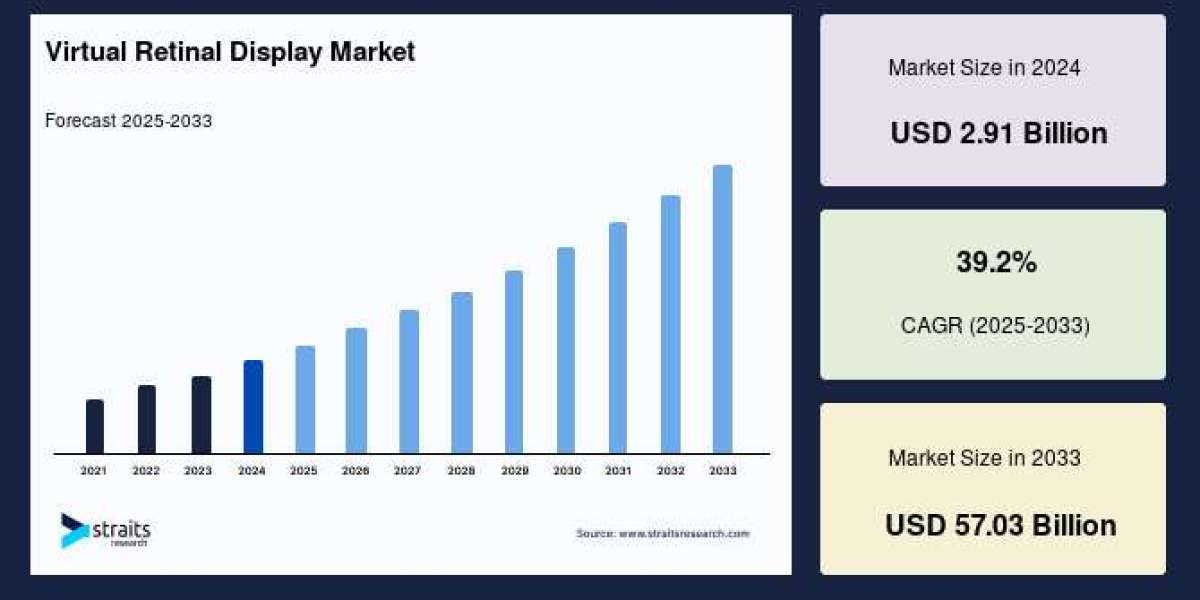The virtual retinal display (VRD) market — which projects images directly onto the retina using scanning lasers, micro-LEDs, or related light-engine architectures — is moving rapidly from research labs toward commercial near-eye systems for AR, enterprise wearables, and specialized medical and defense applications. Industry experts expect significant growth as miniaturization, power efficiency, and manufacturing scale improve.
Request a Sample Report@ https://straitsresearch.com/report/virtual-retinal-display-market/request-sample
Latest Trends
Micro-LED and laser-scanning momentum: Advancements in micro-LED retinal projection and refined laser-beam scanning architectures are enabling brighter, higher-contrast images with lower power consumption.
Component specialization & supply chain: New players focusing on AR light-engines and MEMS scanners are shifting value toward component suppliers and module makers.
Enterprise-first commercialization: Early VRD deployments are concentrated in enterprise, industrial, defense, and medical applications where ROI and certification are clearer than consumer adoption.
Convergence with sensing stacks: Companies integrating retinal projection optics with sensors for spatial awareness are creating competitive AR headset advantages.
Short Overview of Segments — A, B, C
Segment A — By Technology
This segment distinguishes laser-beam scanning VRDs, micro-LED retinal projection, and hybrid systems. Laser scanning offers excellent contrast and long focal depth; micro-LEDs provide compact emissive displays; hybrids balance performance with reduced safety concerns.
Segment B — By Application
Key applications include:
Enterprise/Industrial (maintenance, field service)
Defense & Aerospace (helmet displays, targeting systems)
Healthcare (surgical visualization, vision therapy)
Consumer (AR glasses for gaming, navigation)
Enterprise and defense currently dominate due to clearer ROI and adoption pathways.
Segment C — By Region
North America & Asia-Pacific: Leading in R&D and adoption, backed by defense contracts and AR innovation hubs.
Europe: Focusing on specialized medical and industrial pilots.
Top Players & Recent Developments
MicroVision, Inc.: Leveraging MEMS laser scanning expertise, with a focus on industrial and perception markets.
Magic Leap & Component Makers: Developing VRD-style light engines for enterprise AR, with strong contributions from component suppliers in optics and micro-LEDs.
Research Institutions: Advancing micro-LED retinal projection with full-color, low-power systems that are shaping future AR glasses.
Challenges
Eye-safety and regulations: Direct retinal illumination demands strict compliance with safety standards.
Manufacturing scale & cost: High costs of micro-LED and MEMS components limit mass adoption.
Power, ergonomics & FOV tradeoffs: Balancing device weight, brightness, and battery life remains difficult.
Ecosystem readiness: Limited content and software tools slow widespread adoption.
Opportunities
Enterprise solutions: Industrial, medical, and defense applications offer premium early adoption markets.
Light-engine licensing: Standardized VRD modules create revenue opportunities for suppliers.
Assistive technologies: Retinal displays can enhance medical visualization and support low-vision aids.
Purchase the Full Report@ https://straitsresearch.com/buy-now/virtual-retinal-display-market
Most-Asked / Trending FAQs
1. What is a virtual retinal display (VRD)?
A VRD projects patterned light directly onto the retina, producing high-contrast images.
2. Are VRDs safe for the eyes?
Yes, when designed under strict standards that regulate laser power and compliance.
3. When will consumer VRD AR glasses be available?
Consumer adoption is expected in the coming years, though enterprise and medical markets lead adoption first.
4. Which companies are leading in VRD technology?
Players include AR device makers, laser scanning specialists, and micro-LED innovators.
5. How does micro-LED compare to waveguides?
Micro-LED offers higher brightness and contrast, while waveguides face efficiency tradeoffs.
Conclusion
The virtual retinal display market is at a turning point. Breakthroughs in micro-LEDs and scanning technologies, coupled with a maturing supply chain, are positioning VRD as a viable option for enterprise, defense, and medical markets. Overcoming cost, regulatory, and ergonomic challenges will be critical for consumer adoption. Companies that successfully deliver efficient, safe, and comfortable VRD solutions will be well-placed to lead the next generation of AR innovation.
About Us
Straits Research is a market intelligence company providing global business information reports and services. Our exclusive blend of quantitative forecasting and trends analysis provides forward-looking insight for thousands of decision-makers. Straits Research Pvt. Ltd. provides actionable market research data, especially designed and presented for decision making and ROI.
Whether you are looking at business sectors in the next town or crosswise over continents, we understand the significance of being acquainted with the client’s purchase. We overcome our clients’ issues by recognizing and deciphering the target group and generating leads with utmost precision. We seek to collaborate with our clients to deliver a broad spectrum of results through a blend of market and business research approaches.
Contact Us
Phone: +1 646 905 0080 (U.S.), +44 203 695 0070 (U.K.)
Email: sales@straitsresearch.com








